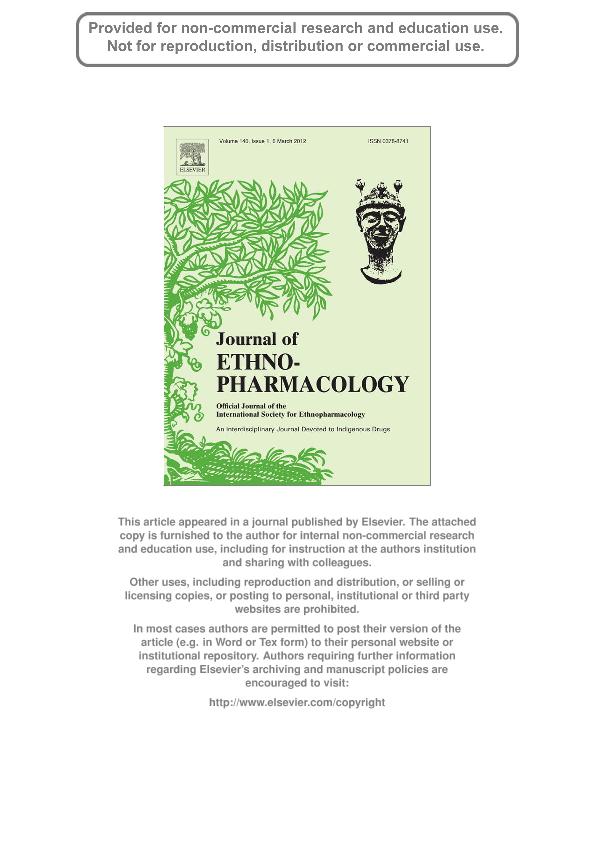Artículo
Involvement of the l-arginine-nitric oxide pathway in the antinociception caused by fruits of Prosopis strombulifera (Lam.) Benth.
Saragusti, Alejandra Cristina ; Bustos, Pamela Soledad
; Bustos, Pamela Soledad ; Pierosan, Luana
; Pierosan, Luana ; Cabrera, Jose Luis
; Cabrera, Jose Luis ; Chiabrando, Gustavo Alberto
; Chiabrando, Gustavo Alberto ; Soares Dos Santos, Adair
; Soares Dos Santos, Adair ; Ortega, María Gabriela
; Ortega, María Gabriela
 ; Bustos, Pamela Soledad
; Bustos, Pamela Soledad ; Pierosan, Luana
; Pierosan, Luana ; Cabrera, Jose Luis
; Cabrera, Jose Luis ; Chiabrando, Gustavo Alberto
; Chiabrando, Gustavo Alberto ; Soares Dos Santos, Adair
; Soares Dos Santos, Adair ; Ortega, María Gabriela
; Ortega, María Gabriela
Fecha de publicación:
01/2012
Editorial:
Elsevier Ireland
Revista:
Journal Of Ethnopharmacology
ISSN:
0378-8741
1872-7573
1872-7573
Idioma:
Inglés
Tipo de recurso:
Artículo publicado
Clasificación temática:
Resumen
Ethnopharmacological relevance
Prosopis strombulifera (Lam.) Benth. is a rhizomatous shrub that grows in the north and central zone of Argentina. In folk medicine, the fruits of this plant have been used as an astringent, anti-inflammatory and odontalgic agent and anti-diarrheic.
Aim of the study
To investigate the antinociceptive effect of ethanol (EE), chloroform (CE) and ethyl acetate (EtOAcE) extracts of Prosopis strombulifera fruits and the involvement of the l-arginine-nitric oxide pathway in this effect.
Materials and methods
The antinociceptive effects of the EE, CE and EtOAcE of Prosopis strombulifera fruits were evaluated in vivo using the formalin-induced pain test in mice with aspirin and morphine as reference antinociceptive compounds. The participation of the l-arginine-nitric oxide pathway in the antinociceptive effect was investigated in the same animal model using l-arginine as a nitric oxide (NO) precursor. The in vitro inhibitory effect of the extracts on LPS-induced nitric oxide production and iNOS expression was investigated in a J774A.1 macrophage-derived cell line.
Results
CE (300 mg/kg), in contrast to EE and EtOAcE, caused significant inhibition (p < 0.05) of the in vivo nociceptive response. Moreover, CE (100–1000 mg/kg, p.o.) produced a dose-dependent inhibition of the neurogenic and the inflammatory phases of the formalin test with inhibition values (at 600 mg/kg) of 42 ± 7% and 62 ± 7%, respectively. CE inhibition was more potent in the inflammatory phase, with an ID50 of 400.1 (252.2–634.8) mg/kg. The antinociception caused by CE (600 mg/kg, p.o.) was significantly attenuated (p < 0.05) by i.p. treatment of mice with l-arginine (600 mg/kg). In addition, CE (100 μg/mL) produced significant in vitro inhibition (p < 0.001) of LPS-induced NO production, which was not observed with EE and EtOAcE at the same concentration. The inhibition of NO production by CE (10–100 μg/mL) was dose-dependent, with an IC50 of 39.8 (34.4–46.1) μg/mL, and CE significantly inhibited LPS-induced iNOS expression in J774A.1 cells.
Conclusions
This study supports, in part, the ethnomedical use of Prosopis strombulifera fruits by showing that its CE produces moderate antinociception in vivo. The findings also provide scientific information for understanding the molecular mechanism involved in the analgesic effect of this plant.
Archivos asociados
Licencia
Identificadores
Colecciones
Articulos(CCT - CORDOBA)
Articulos de CTRO.CIENTIFICO TECNOL.CONICET - CORDOBA
Articulos de CTRO.CIENTIFICO TECNOL.CONICET - CORDOBA
Articulos(IMBIV)
Articulos de INST.MULTIDISCIPL.DE BIOLOGIA VEGETAL (P)
Articulos de INST.MULTIDISCIPL.DE BIOLOGIA VEGETAL (P)
Citación
Saragusti, Alejandra Cristina; Bustos, Pamela Soledad; Pierosan, Luana; Cabrera, Jose Luis; Chiabrando, Gustavo Alberto; et al.; Involvement of the l-arginine-nitric oxide pathway in the antinociception caused by fruits of Prosopis strombulifera (Lam.) Benth.; Elsevier Ireland; Journal Of Ethnopharmacology; 140; 1; 1-2012; 117-122
Compartir
Altmétricas



